Irish stew is the perfect dish for a cool fall day or any day of the year. Warm up with a hearty bowl of filling Irish stew!
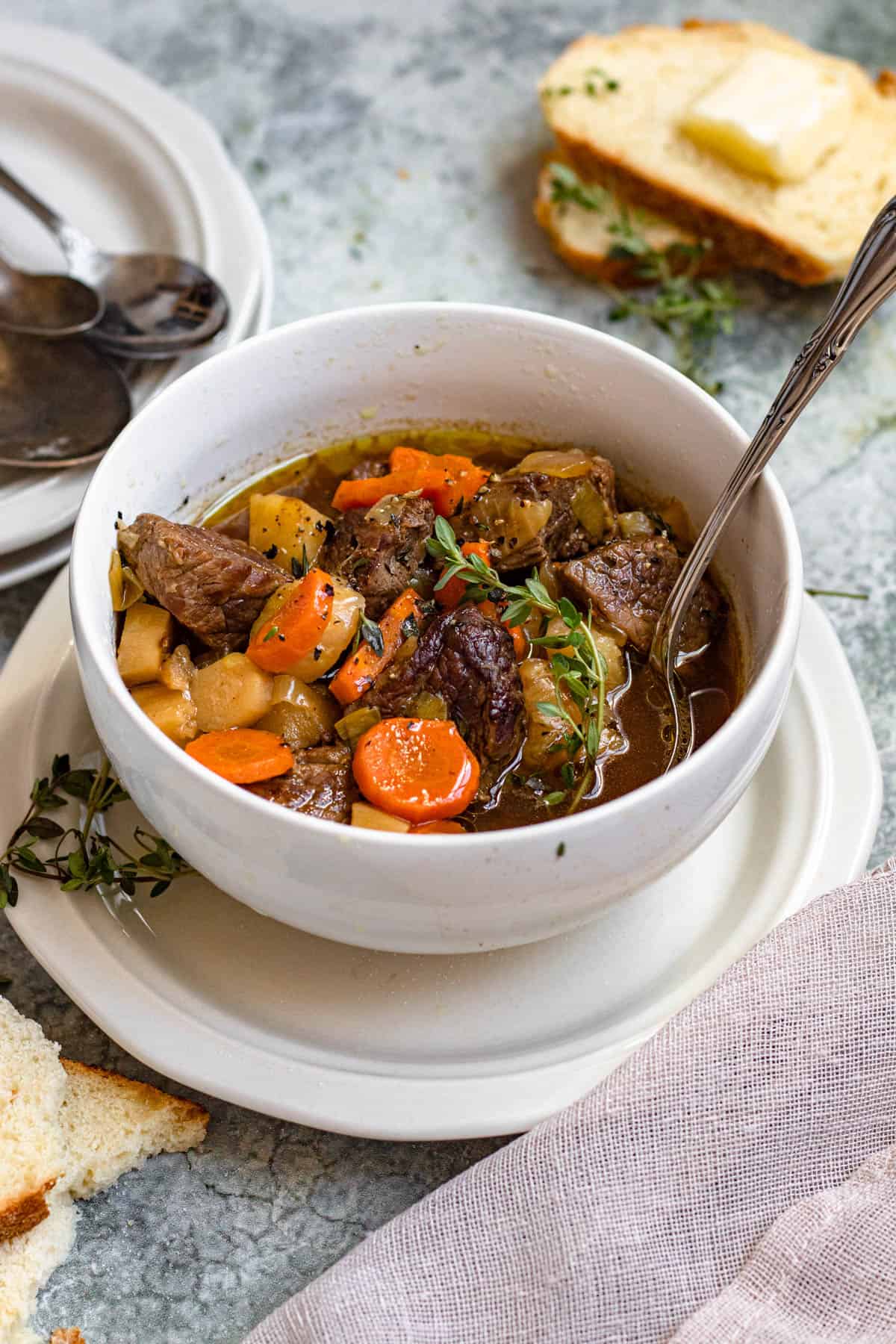
It’s finally sweater weather and if you are relishing cooler temperatures and all the deliciously warm soups you can finally make–you should add this one to your list.
A good Irish beef stew is meaty, filling and full of great flavor. It’s one of those meals that was born of necessity but has carried on through generations because it is simply so good and so easy to make for a weeknight dinner or a special occasion. It’s particularly popular in the United States on St. Patrick’s Day, but this dish is too good to only be enjoyed once a year.
This recipe was provided to me by a reader, Mark Costello. The Costello family lives in Ireland and makes this recipe frequently. Thanks for the help, Mark!
Recipe Origins
Irish stew has been around since the 1800s, but stews in general have been around since ancient times.
Stewing became popular in Ireland in the 19th century when famine struck the land and many families were suffering financially. With just one pot and a few ingredients, those living in poverty could create a meal that would fill their family’s stomachs and keep everyone healthy.
Traditional Irish stew is built on a few basic ingredients: mutton (sheep), onions and potatoes. Any other vegetable could be added as well like turnips, carrots, squash or mushrooms.
Stewing was a popular way to cook mutton because even the toughest cuts eventually turned soft and tender when slow cooked–which allowed people to use every bit of meat. Similarly, you could always find potatoes even when food was scarce so Colcannon is another delicious Irish recipe to try.
This hearty meal became a very popular dish on holidays like St. Patrick’s Day and Samhain, a pagan religious festival celebrated on October 31st that celebrates the end of the harvest and ushers in the colder season. This holiday is the origin of Halloween.
Many Irish families immigrated to the United States during the 18th century, escaping the famine. In America sheep were not as widely available, so many chefs began using beef instead.
Over time the stew has adapted and evolved but that’s the great thing about stew. You can use whatever you have! Some chefs add wine, beer or worcestershire sauce, while others try out different herbs to add more depth to the broth.
The simpler recipes are more traditional, as the recipe originated from poor farmers. But, like most homemade dishes, everyone has their variation. A classic, hearty Irish stew is actually the national dish of Ireland.
Why Make This Recipe
- Easy Weeknight Meal: You only need one pot to cook up this stew and while it may take time to cook, it’s easy to prepare your ingredients and let it simmer over medium heat while you’re busy with other tasks.
- Filling and Satisfying: Nothing warms up a cold day like a bowl of hearty stew. This recipe is so filling and satisfying!
- Taste an Irish Tradition: Irish stew has been served for generations and is especially popular for Irish holidays. Why not make every day feel like a holiday?
What Do I Need to Make This Recipe?
Ingredients
Here is a visual overview of the ingredients in the recipe. Scroll down to the recipe at the bottom for quantities.
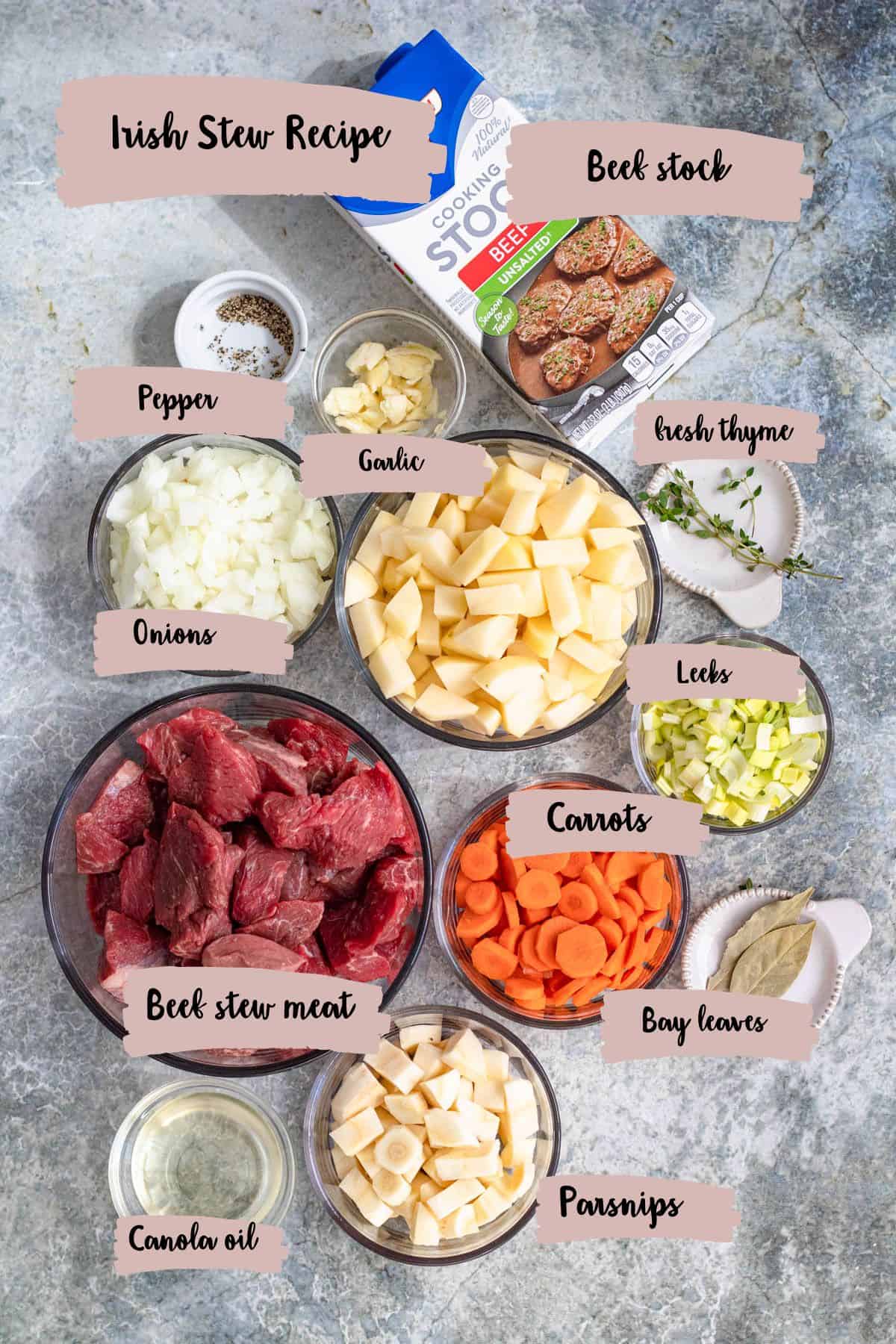
- Beef Stew Meat: Mutton is more traditional in this recipe, but you can keep things easy by using pre-cut beef stew meat. You could use lamb stew meat or you could purchase a beef chuck roast and cut it into smaller pieces.
- Vegetables: You can add just about any root vegetables you like but for this recipe I added yellow onion, carrots, leeks, and parsnips. No stew would be complete without potatoes as well. I like to use russet potatoes.
- Herbs: Fresh thyme and a bay leaf is all you need to add flavor to this dish, but you could also add some fresh parsley
- Beef Stock: You can also use chicken stock if necessary
Tools
- Dutch Oven: Use a Dutch oven on your stovetop if you have one. If you don’t, a large pot will work just fine. You could also easily adapt this recipe for a slow cooker or instant pot but the cooking time will vary.
How to Make This Recipe
[adthrive-in-post-video-player video-id=”oE5HomeY” upload-date=”2022-10-24T02:25:26.000Z” name=”Irish Stew Recipe” description=”Irish stew is the perfect dish for a cool fall day or any day of the year. Warm up with a hearty bowl of filling Irish stew!” player-type=”default” override-embed=”default”]
Step 1: Sear the Beef
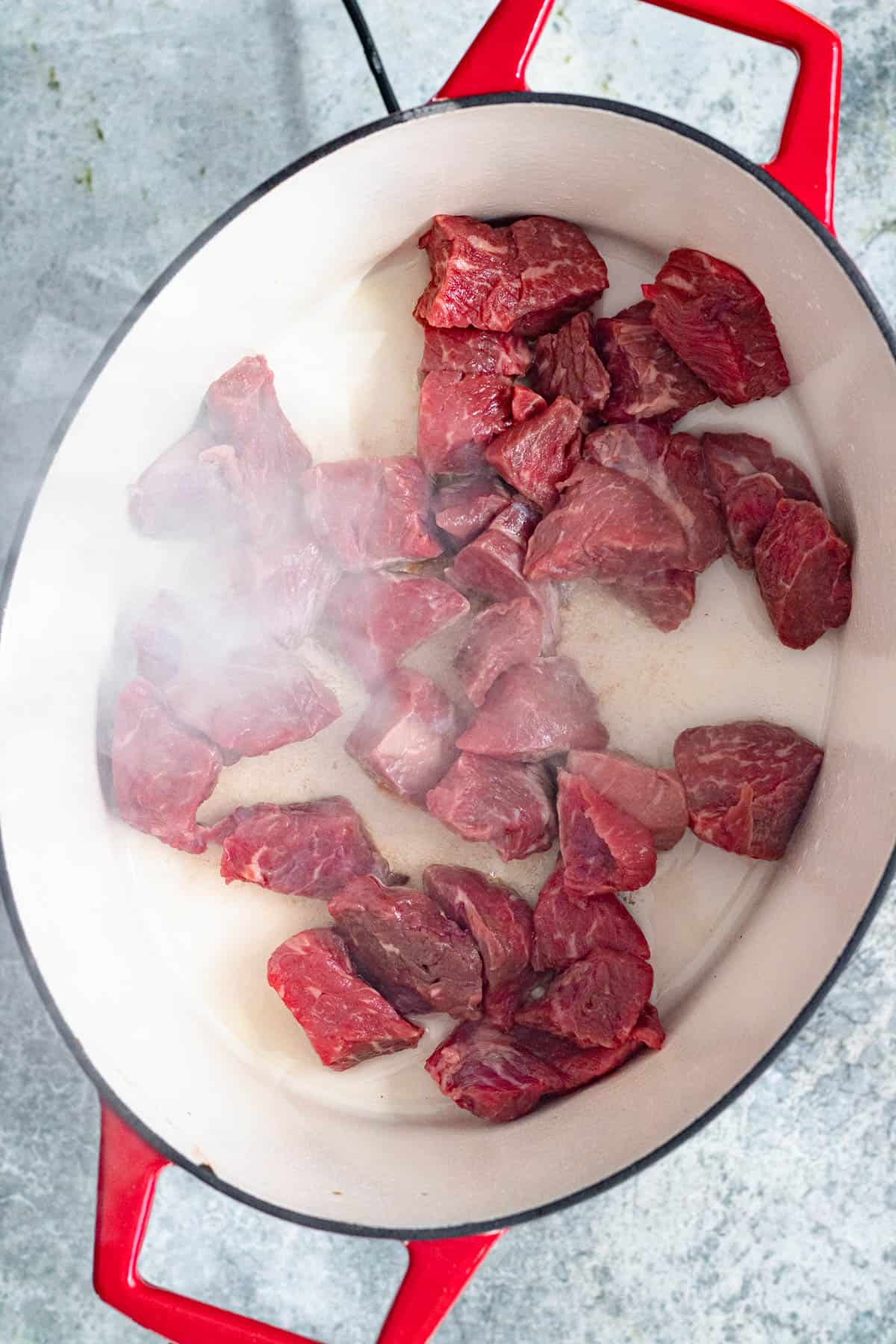
In a large dutch oven, warm 3 tbsp oil over medium-high heat. Add the beef cubes and sear until the outsides have browned.
Remove to a plate and set aside.
Step 2: Add your Vegetables
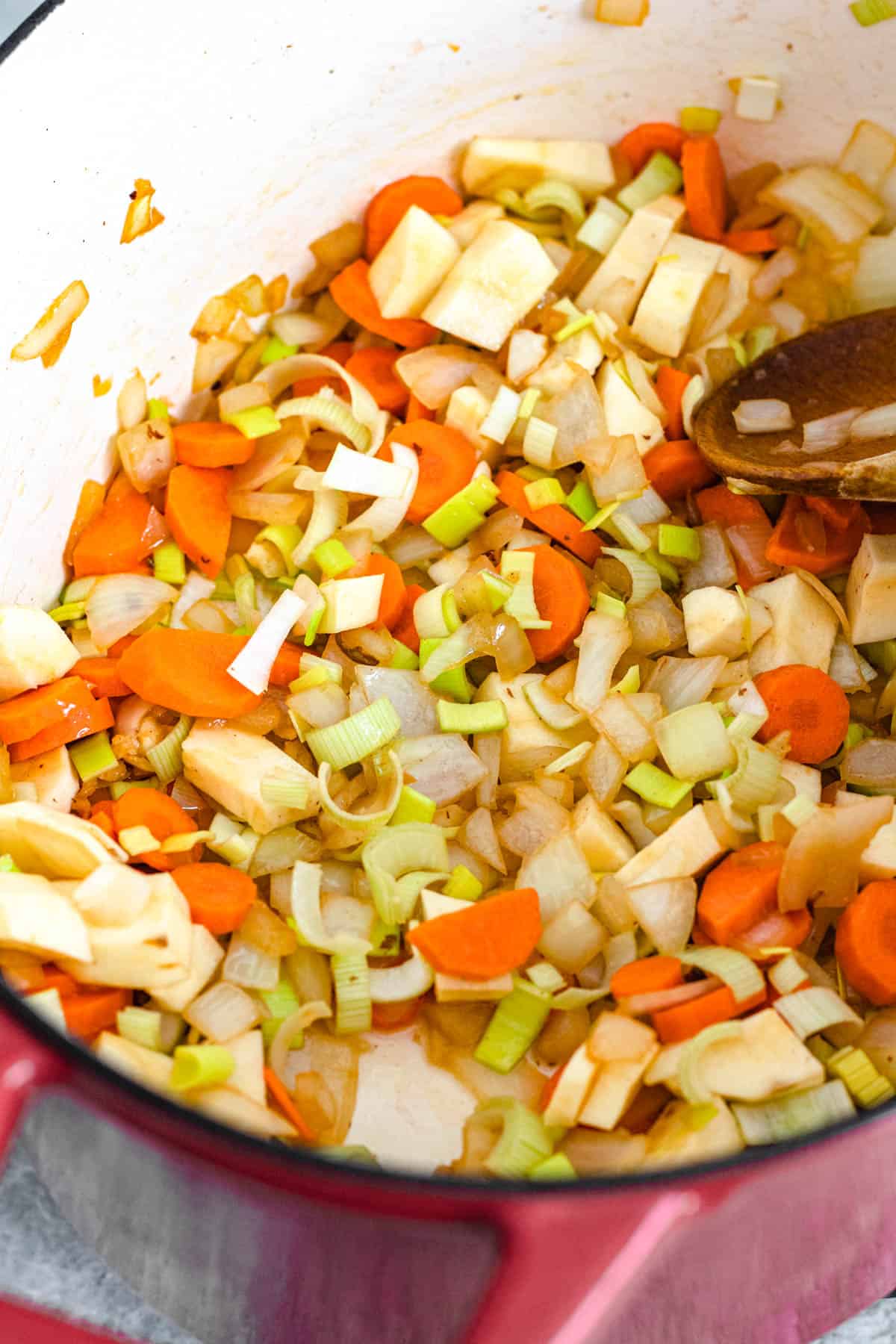
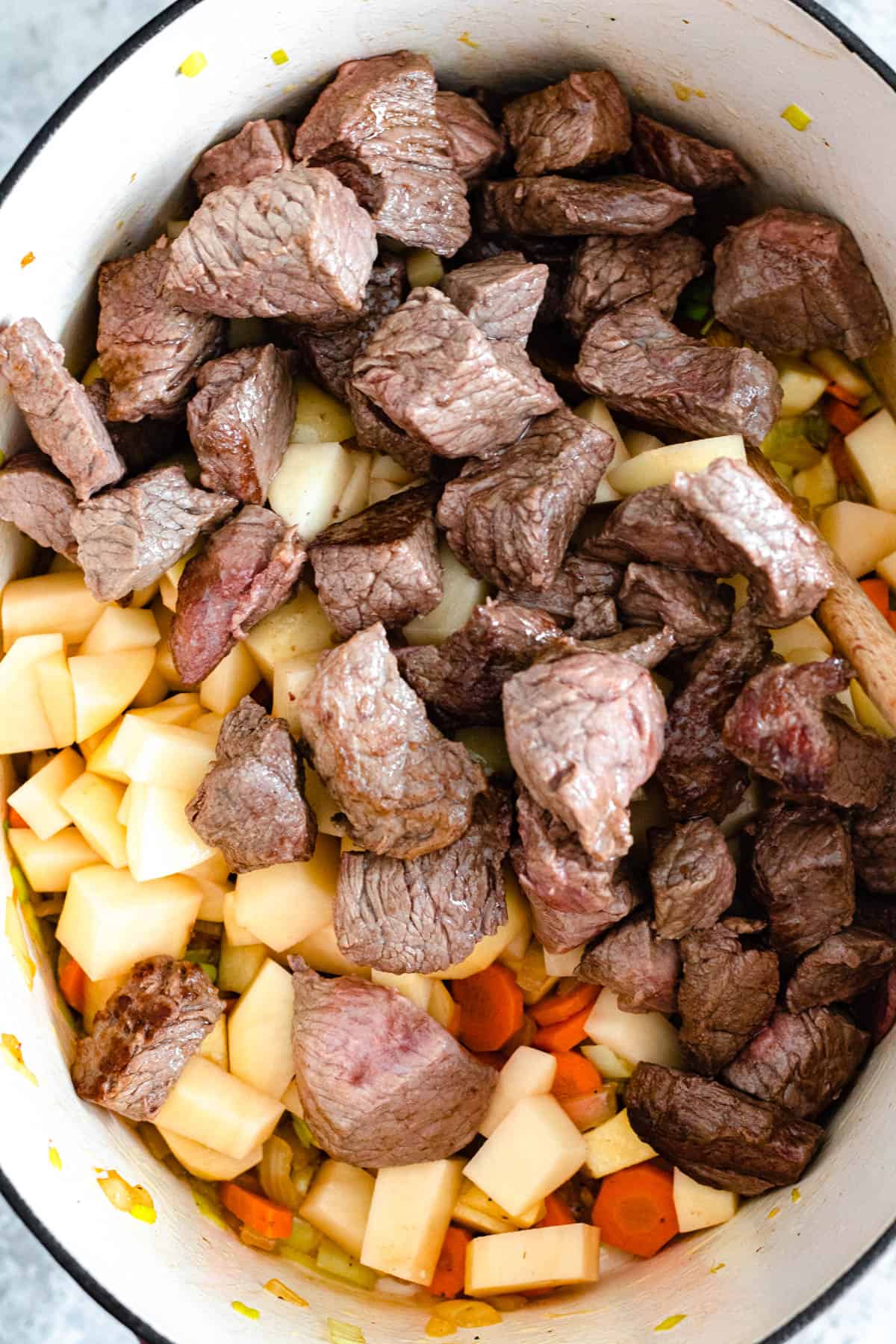
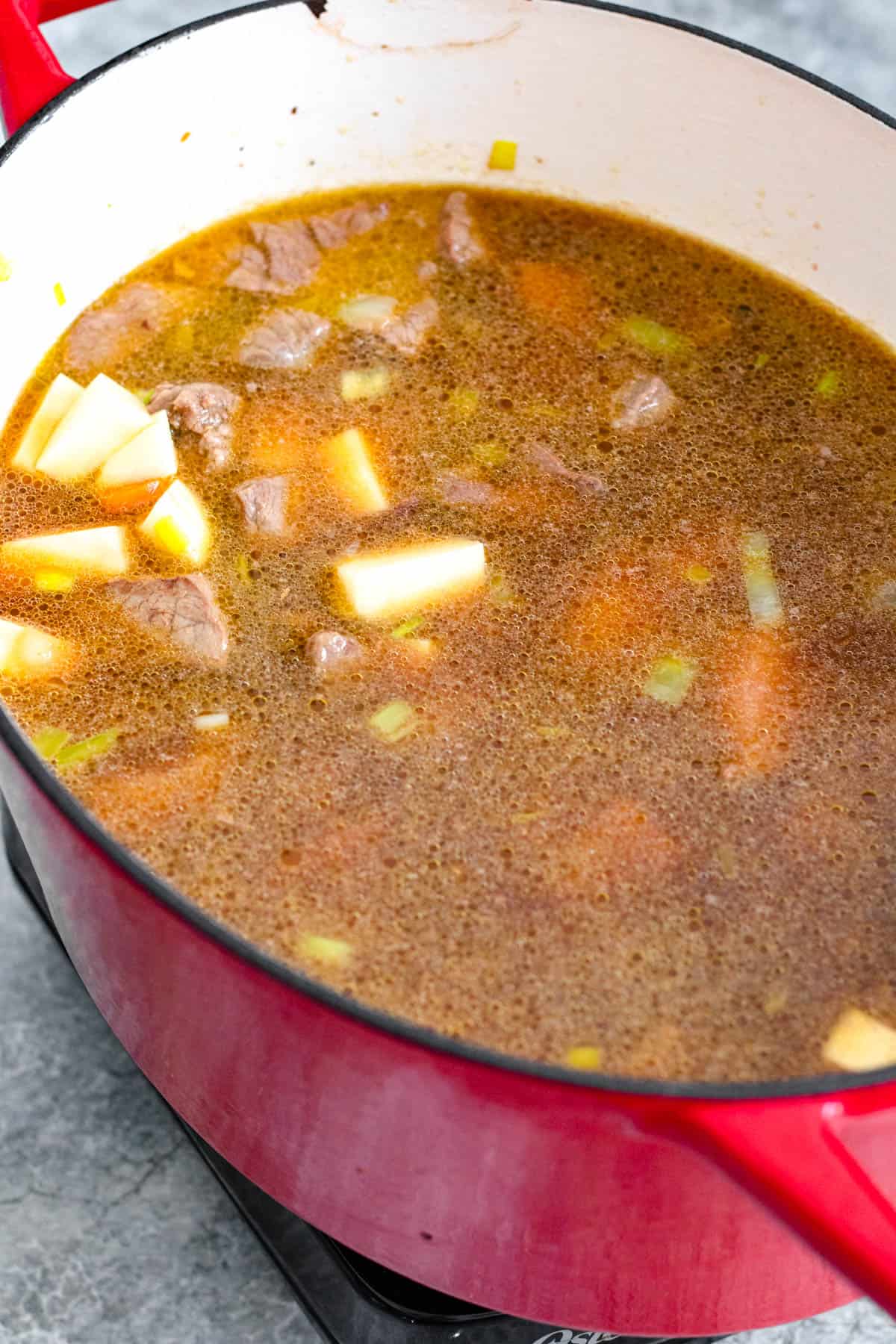
Add 1 tbsp oil into the pot and add the garlic and onion. Cook until translucent and aromatic.
Add the carrot, leek, and parsnip and cook, stirring occasionally, for about 5 minutes until softened.
Add the thyme, bay leaves, and black pepper. Cook again for about 5 minutes.
Add the potatoes and the seared meat into the pot along with the warm stock.
Step 3: Let it Simmer
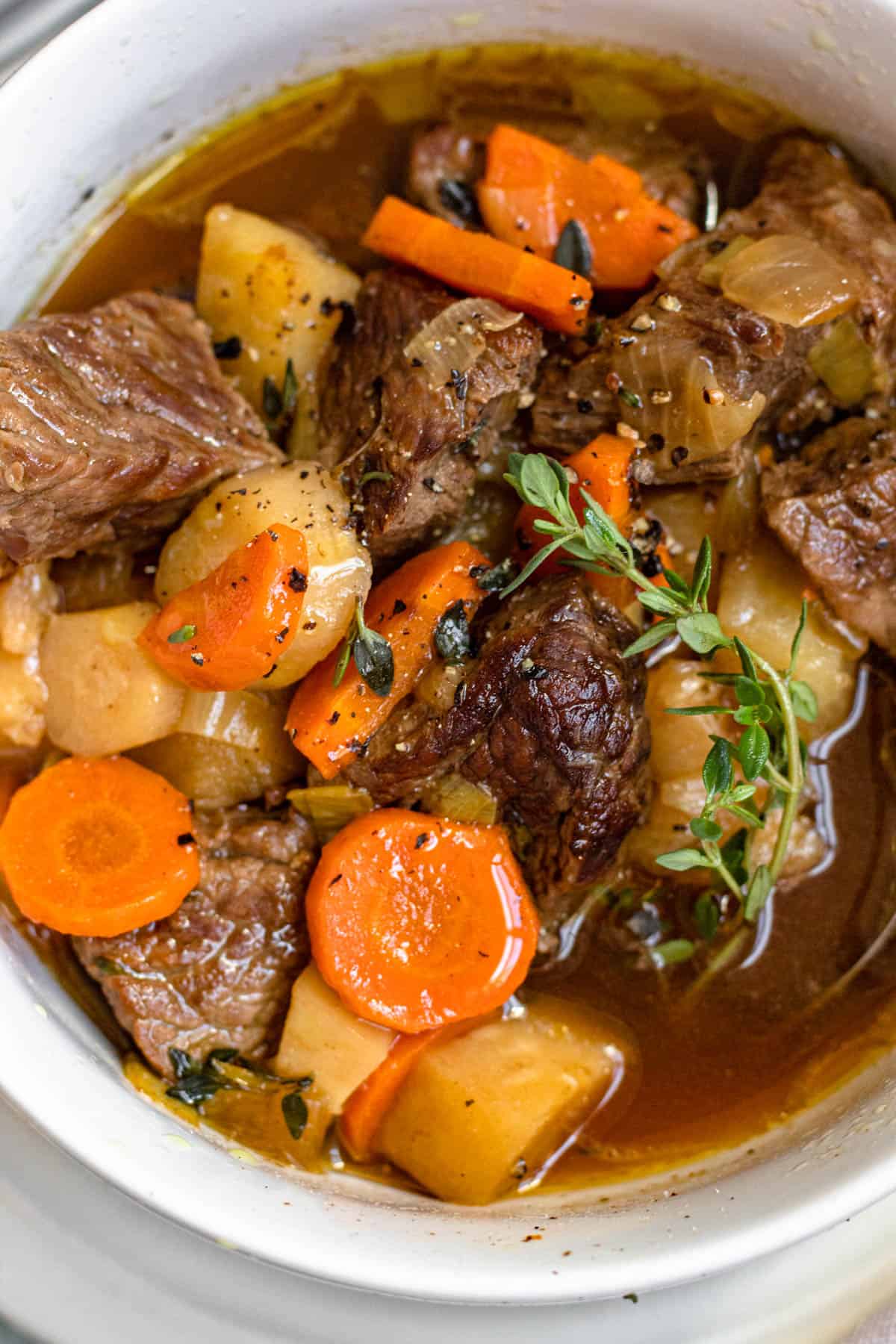
Cover the dutch oven with a lid, and bring the stew to a boil. Reduce the stew to a simmer and allow it to simmer for about an hour, stirring occasionally.
After an hour, check if the meat is tender. If it is not, cook for another 20 minutes. When the meat is tender, serve with some crusty bread and enjoy!
Expert Tips
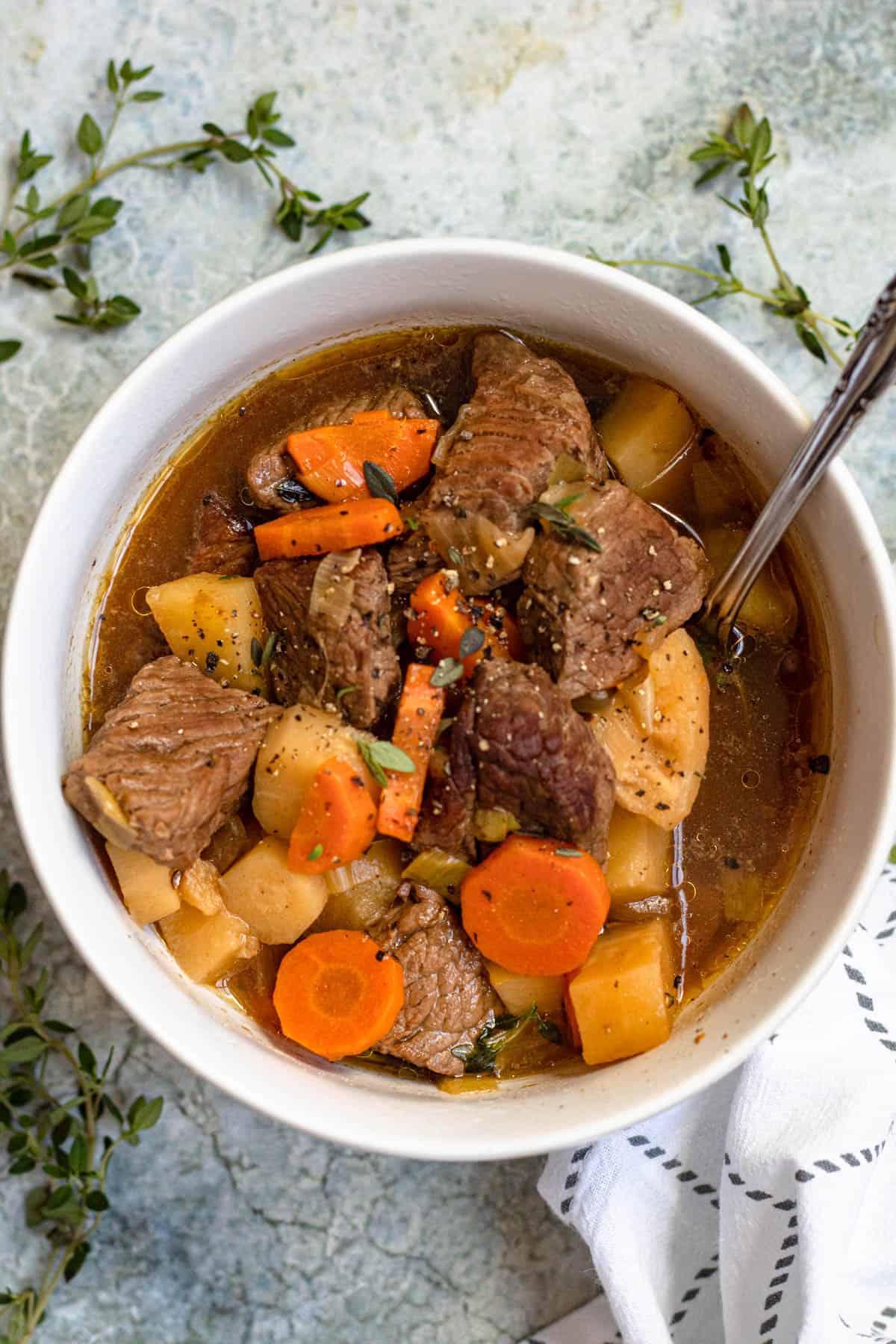
- Some chefs like to replace some of the stock with red wine or Guinness beer (this is called Guinness Stew). Feel free to give it a try if you like!
- Cabbage is a great addition to this stew. I recommend adding about 1 cup of young cabbage leaves into the stew about 10 minutes before serving.
- This dish is delicious when served over mashed potatoes. I also like sprinkling a little cheese on top for a non-traditional but delicious finish.
- Cooking the stew slowly over low heat will create the best flavor. Don’t rush it! You can simmer the stew for hours if you have the time and want a really tender meat.
- It’s okay to cut your vegetables into slightly larger bite-sized pieces. They will be cooked well during the long cooking time and if diced too small they may fall apart completely.
- You can use just about any kind of potato for this recipe. Russet potatoes will break down more and make your stew thick and hearty. Less starchy potatoes like red potatoes or fingerlings will hold their shape better but won’t contribute as much to the texture of your stew. Which variation you use is up to you.
FAQs
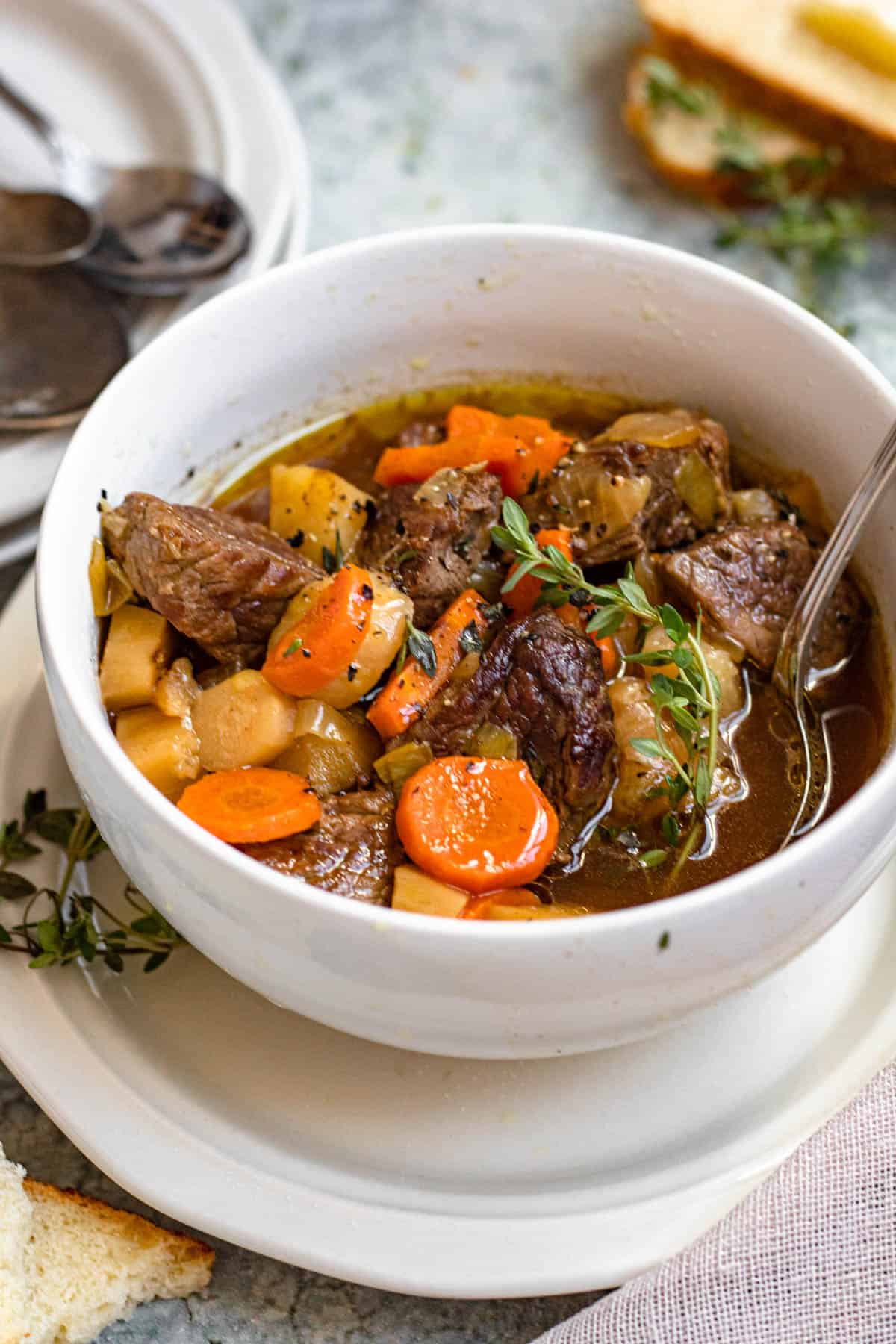
There is not a great difference between Irish stew and beef stew. Irish stew is historically made using mutton, while beef stew is made with beef.
There are several ways to thicken your stew:
-As mentioned above, using russet or starchy potatoes will help create a thicker stew. No matter the type of potato, mashing a few will help thicken your stew.
-You can try simmering your stew for a few minutes without the lid on. This allows some moisture to escape.
-You can also add a small amount of cornstarch in a cornstarch slurry to thicken your stew if you want a thicker base.
This recipe can easily be adapted for use in the slow cooker. To do, follow these simple instructions:
1. Brown the meat, onions and garlic.
2. Place all of the ingredients in a crock pot and place the lid on top.
3. Cook on low for 6-8 hours. Serve!
Just about any vegetables will make a good addition to this stew. You could try adding peas, green beans, mushrooms, butternut squash or even sweet potatoes.
This dish makes for excellent leftovers! Keep it in an airtight container in the fridge for three to five days or in the freezer for up to two months. You may need to add some water when you reheat it.
Did you like this Irish Stew Recipe? If so, make sure to check out these other recipes I picked out just for you:
- Seswaa from Botswana
- Chickpea Stew from Algeria
- Plokkfiskur from Iceland
- Zigni (Beef Stew from Eritrea)
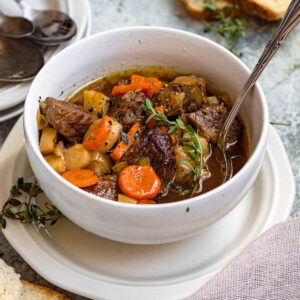
Irish Stew Recipe
Equipment
- Dutch Oven
- Oven Mitt
Ingredients
- 4 tbsp Canola Oil
- 2 lb beef stew meat
- 2 cloves garlic, crushed
- 1 yellow onion, peeled and diced
- 2 carrots, peeled and diced
- ½ leek, cleaned and diced
- 1 parsnip, peeled and diced
- 2 sprigs of fresh thyme
- 2 bay leaves
- ½ tsp Fresh Ground Black Pepper to Taste (Use code FF20 for 20% off)
- 3 Russet potatoes, peeled and diced
- 2 quarts warm beef stock
Instructions
- In a large dutch oven, warm 3 tbsp oil over medium-high heat. Add the 2 lb beef and sear until the outsides have browned. Remove to a plate and set aside.
- Add 1 tbsp oil into the pot and add the 2 cloves garlic and the diced onion. Cook until translucent and aromatic.
- Add the 2 carrots, ½ leek, and parsnip and cook, stirring occasionally, for about 5 minutes until softened.
- Add the sprigs of thyme, 2 bay leaves, and ½ tsp black pepper. Cook again for about 5 minutes.
- Add the 3 potatoes and the seared meat into the pot along with the warm stock.
- Cover the dutch oven with a lid, and bring the stew to a boil. Reduce the stew to a simmer and allow it to simmer for about an hour, stirring occasionally.
- After an hour, check if the meat is tender. If it is not, cook for another 20 minutes. When the meat is tender, serve and enjoy!
Notes
- Beef Stew Meat: Mutton is more traditional in this recipe, but you can keep things easy by using pre-cut beef stew meat. You could use lamb stew meat or you could purchase a beef chuck roast and cut it into smaller pieces.
- Vegetables: You can add just about any root vegetables you like but for this recipe I added yellow onion, carrots, leeks, and parsnips. No stew would be complete without potatoes as well. I like to use russet potatoes.
- Herbs: Fresh thyme and a bay leaf is all you need to add flavor to this dish, but you could also add some fresh parsley
- Beef Stock: You can also use chicken stock if necessary
- Some chefs like to replace some of the stock with red wine or Guinness beer (this is called Guinness Stew). Feel free to give it a try if you like!
- Cabbage is a great addition to this stew. I recommend adding about 1 cup of young cabbage leaves into the stew about 10 minutes before serving.
- This dish is delicious when served over mashed potatoes. I also like sprinkling a little cheese on top for a non-traditional but delicious finish.
- Cooking the stew slowly over low heat will create the best flavor. Don’t rush it! You can simmer the stew for hours if you have the time and want a really tender meat.
- It’s okay to cut your vegetables into slightly larger bite-sized pieces. They will be cooked well during the long cooking time and if diced too small they may fall apart completely.
- You can use just about any kind of potato for this recipe. Russet potatoes will break down more and make your stew thick and hearty. Less starchy potatoes like red potatoes or fingerlings will hold their shape better but won’t contribute as much to the texture of your stew. Which variation you use is up to you.







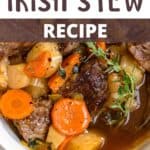

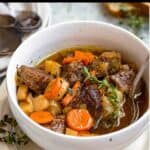

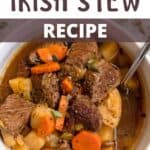

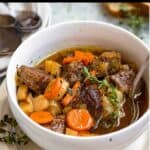
Beth says
Do you simmer with the lid off or on?
Alexandria Drzazgowski says
with the lid on!